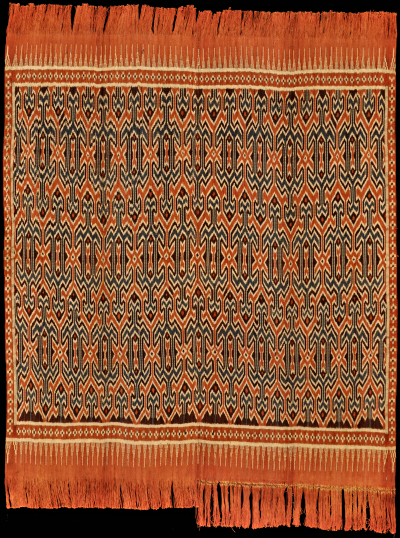| |
 
 | | | |
067 Sulawesi, Toraja
Seko mandi (shroud)  
| | Locale: | Galumpang district. | | Period: | 1970s | | Yarn: | Cotton, hand-spun, coarse; quad-ply warp interlaced with quadruple weft. | | Technique: | Warp ikat | | Panels: | 2 | | Size: | 135 x 158 cm (4' 5" x 5' 2") LW: 1.17 | | Weight: | 1040 g (36.7 oz), 488 g/m2 (1.60 oz/ft2) | | Design: | Seko mandi, shroud. Shimmery, interlocking patterns called lelesepun represent stylised human figures, which symbolize the ancestors which the owner will join in the afterlife. Note that in literature seko mandi with lelesepun patterning are sometimes called referred to as lelesepun. | | Comment: | Khan Majlis: 'Tiny offsets in the positioning of the rows of diamonds, diagonal connecting lines and alternation between light and dark fill the sequence of simple ornaments with tension and life.' Ethnographer Carl Schuster (cited by Dallas Museum of Art) interpreted the human figures as ancestors, gathered together on the burial shroud to accompany the deceased into the next world. One use of these sacred blankets, handed down to successive generations, was to catch honoured family membersí last breath, irrevocably linking them to the ancestors, and over time giving them a gravitas that is felt not just by the Toraja, and a palpable presence. This is a 'revival' piece dating from the period after the temporary flight from Tanah Toraja during the persecution of 'heathen' mountain peoples by Muslims from southern Sulawesi, though one with overage ikat work. | | Background: | Chapters on Sulawesi and Toraja. | | Exhibited: | Museu do Oriente, Lisbon, 2014/15. | | Published: | Woven Languages, 2014. | | Compare: | 066 068 201 214 | | Sources: | Similar to seko mandi depicted in Gillow, Traditional Indonesian Textiles, Fig. 82. Similar to seko mandi from Galumpang in British Museum, Nr. 1987,01.7. Also similar to old seko mandi in Dallas Museum of Art, Object Nr. 1983.126, and one in Wassing-Visser, Weefsels en Adatkostuums uit Indonesië, Fig. 111, , though both have additional side panels that are typical of an older cloth - older than ours and the one in the British Museum. Bezemer in Indonesische Kunstnijverheid, undated but known to have been published in 1931, on Fig. 27 shows a similar example without side panels. | | |

©Peter ten Hoopen, 2025
All rights reserved.
|
|


